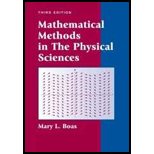
The following expression occurs in statistical mechanics:
Use Stirling’s formula to show that
Want to see the full answer?
Check out a sample textbook solution
Chapter 11 Solutions
Mathematical Methods in the Physical Sciences
Additional Math Textbook Solutions
A Problem Solving Approach To Mathematics For Elementary School Teachers (13th Edition)
Probability and Statistics for Engineers and Scientists
The Heart of Mathematics: An Invitation to Effective Thinking
Differential Equations: An Introduction to Modern Methods and Applications
Mathematics All Around (6th Edition)
Calculus for Business, Economics, Life Sciences, and Social Sciences (14th Edition)
- f(x)=e^x+cos(2x) 2.2 Use the Maclaurin series expansion to approximatef(1.25).2.3 Find the exact value of f(1.25) and compute thepercentage errorarrow_forward. Find the value of e x using series expansion e x = 1 + x + x 2 2! + x 3 3! + · · · for x = 0.5 with an absolute error less than 0.005.arrow_forwardFind the exact value of n! and then approximate n! using Stirling’s Formula. n = 12arrow_forward
- Find the series solution of y''+xy'+y=0. show all the workarrow_forwardCompute the successive approximations yn(x) for n ≤ 3; then compare them with the appropriate partial sums of the Taylor series of the exact solution dy/dx = y + ex, y(0) = 0arrow_forwardGiven f(x)=e^x+cos(2x) 2.2 Use the Maclaurin series expansion to approximatef(1.25).2.3 Find the exact value of f(1.25) and compute thepercentage errorarrow_forward
- Algebra & Trigonometry with Analytic GeometryAlgebraISBN:9781133382119Author:SwokowskiPublisher:Cengage
